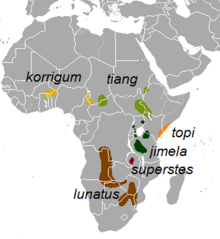| Bangweulu tsessebe | |
|---|---|

| |
| Scientific classification | |
| Domain: | Eukaryota |
| Kingdom: | Animalia |
| Phylum: | Chordata |
| Class: | Mammalia |
| Order: | Artiodactyla |
| Family: | Bovidae |
| Subfamily: | Alcelaphinae |
| Genus: | Damaliscus |
| Species: | |
| Subspecies: | D. l. superstes
|
| Trinomial name | |
| Damaliscus lunatus superstes (Cotterill, 2003)[2]
| |

| |
| Range in red | |
The Bangweulu tsessebe (Damaliscus lunatus superstes) is a population and possible taxon of Damaliscus lunatus (topi or sassaby), which are large African antelopes of the grasslands. This population is presently restricted to northern Zambia in the wild, although it was recorded as occurring in neighbouring southernmost Democratic Republic of the Congo in the 1940s. Also seen as the northernmost population belonging to the nominate southern sassaby subspecies, in 2003 it was described as a new species, only to be downgraded to a subspecies a few years later. Its taxonomic status is unclear as of 2021. As an individual sassaby of this taxon cannot be clearly distinguished from populations to the south, the taxon was defined using an experimental suite of statistical techniques applied to a sample set, based on multivariate analysis, and recognised under an experimental new taxonomy. Nominate sassaby antelopes become progressively darker on average in the northern populations, and on average have slightly thicker horns at the base of the skull, but those of northern Zambia are the darkest and with the most robust horns on average (a mean 4.3% thicker than the Botswana average, compared to 1.2% mean size difference between Botswana and Zimbabwe).
- ^ IUCN SSC Antelope Specialist Group (10 August 2016). "Damaliscus lunatus ssp. superstes (Bangweulu Tsessebe)". IUCN Red List of Threatened Species. 10 August 2016. Retrieved 2018-11-15.
- ^ Biolib.cz (retrieved March 20, 2010.)
